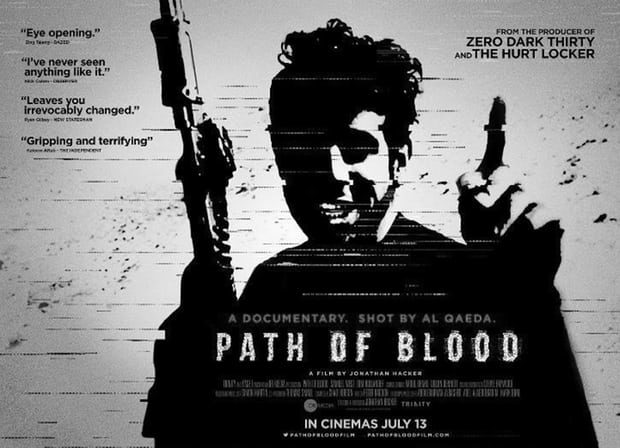
© pathofbloodfilmPath of Blood includes the brutal interrogation of an American hostage.
A Bafta-winning film-maker has defended his decision to make a documentary using video footage taken by jihadist terrorists, saying the work humanises but does not glamorise.
Path of Blood, which opens in cinemas next week, has no narrator or interviewees and relies solely on the raw footage filmed by the terrorists themselves as they plot to detonate car bombs in the Saudi capital, Riyadh.
"People say 'don't give terrorists air time', but what they should say is 'understand these people'. Only by understanding the nature of their faith, the nature of their psychology will you be able to combat them," said Jonathan Hacker.
Hacker, who directed the 2006 documentary Britain's First Suicide Bombers, spent more than a year piecing the film together after gaining access to 500 hours of al-Qaida videos, seized by Saudi military forces at a jihadist training camp in the desert."It was a mammoth, mammoth task," Hacker said. "The translating alone took five months because there was so much jargon, slang and thick accents."
Before being allowed access to the footage, Hacker said, he had to convince Saudi Arabia's interior ministry that he could be trusted with the material. The ministry knew he planned to make a film, he said, but its concerns were about whether it could compromise security.
Shot with jerky handheld cameras, the videos capture a band of terrorists as they prepare to launch suicide attacks at residential compounds, security bases and oil refineries in and around Riyadh."You see that these terrorists are incredibly young, incredibly naive, many of them incredibly stupid, but all of them still capable of great evil," said Hacker.Some of Path of Blood's most haunting footage, which covers the years between 2003 and 2009, is mundane. Men playing football, doing wheelbarrow races in the desert, goofing around drinking coffee, yet only minutes later - in real time - getting into a vehicle, driving to a target and blowing themselves up.
"If you put this stuff into a drama you wouldn't believe it. You'd say that it's not plausible, that it doesn't make sense," Hacker said.Organising the videos into a chronology of events was a painstaking task. But a narrative started to develop, Hacker said, after he obtained video recordings from Saudi security forces too.
Their videos, filmed as a matter of protocol, captured the aftermath of the suicide bombings. They also showed "Muslim victims and Muslims fighting the terrorists, which was a counterbalance to the western-centric view", Hacker said.Describing Path of Blood as a "study of evil" the film-maker admitted that some of the images made for uncomfortable viewing.In one of the film's most disturbing scenes, the American hostage Paul Marshall Johnson is seen gagged, tied up and beaten - all while enduring a brutal interrogation.The film blacks out for a short period, but the sound is kept running as Johnson - who worked in Saudi Arabia as an engineer on Apache helicopters and was kidnapped in 2004 - is murdered.
"I felt with this particular scene, what was important was the line of questioning. While it is unbearably painful it tells you a lot about their mindset," said Hacker. "That's part of the story, that's part of what it means to understand who these terrorists were."
Hacker accepts there will be controversy over some of the scenes but insists that what we learn about the terrorists' beliefs is of huge importance. He said the film showed "these patterns of behaviour - young, naive people looking for simple answers, the sense of camaraderie, the sense of belonging, and in that environment how the power-hungry and the psychotic win through and create environments for evil".
This is similar to how so many Nazi films were later used... to understand them, as an researcher would do... as any seeker needs to do.... how else can you Choose sides if you can't tell the difference? you'd only be following programmed propaganda otherwise... which is a choice, just not an informed one. Seems this dude is doing a service... for various people interested in learning what's going on and why... especially kids that get 'groomed' into this suicide activity.... being played by those they respect etc.